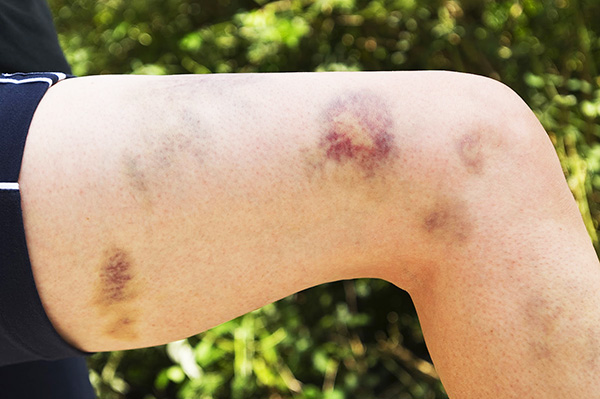A bruise, also called ecchymosis or contusion, refers to a skin discoloration, usually after a trauma. It is associated with pain and tenderness in the area, which may limit a person’s movement and activities of daily living. It disappears on its own, depending on the person’s healing capacity or recovery. The following are the causes, signs and symptoms, and home remedies for a bruise.
Causes
A bruise has multiple causes. As per Web MD, it occurs in some people who do vigorous exercise; they include athletes and weigh lifters. Bruising may also be attributed to a bleeding disorder, such as hemophilia or dengue hemorrhagic fever, in which bruising may be accompanied by petechiae or nose bleeding. Trauma is a usual cause, such as when bumping to a hard solid surface, such as a bedpost. Taking blood thinning medications also contribute to bruising, since they encourage bleeding. The elderly is prone to bruising, since the tissues that support the underlying blood vessels are more fragile than those of the other stages of life.
Signs and Symptoms
A bruise presents various signs and symptoms. According to Web MD, a fresh bruise may appear reddish and turns blue or purple after a few hours. Then, it becomes yellow or green after a few days as it continues to heal. As per the publication, it is commonly tender and painful for the first few days; however, the pain subsides as the color goes away. It is added that infection is not a risk, since there is no skin break in a bruise.
Home Remedies
Bruises may be treated with over-the-counter medications for pain, but remedies can also be done to manage the condition and support recovery.
Cold and Heat Therapy
Cold and heat application is one way to treat a bruise without medications, since it reduces swelling in the area. According to Best Health Magazine, applying ice on the area decreases pain and promotes faster healing. To add, cold therapy reduces blood flow to the area and provides compression to reduce discoloration. Forms of cold application include a cloth soaked ice-cold water and a bag of frozen vegetables; they are wrapped in a towel and is laid over the bruise for ten minutes, taken off after that and reapplied after 20 minutes.Then, heat is applied to promote blood circulation and clear the pooled blood.
Aloe Vera
One remedy for bruises is alow vera. According to Dr. Weil’s official website, the plant helps soothe skin irritation. As per “Herbs for Health and Healing” author Kathi Keville, as cited by the publication, one can make a bruise compress by adding a tablespoon of arnica tincture, witch hazel bark, chamomile flowers, four drops of lavender oil, St. John’s wort flowering tops, and two tablespoons of cold water.
Pineapple and Cabbage
Two other remedies for bruises include pineapple and cabbage. According to David Wolfe’s official website, pineapple contains bromelain, an enzyme that helps in blood clot break down and swelling reduction. Then, cabbage is rich in vitamin C, which promotes healing, and vitamin K, which promotes blood clotting. The pineapple can be eaten or turned into a smoothie while the cabbage leaves are dipped in hot water and are applied to the bruise. The vegetable can also be used as ingredients in the meals for nutrient absorption.
A bruise is considered a skin discoloration secondary to trauma or other factors and it is usually accompanied by pain, which restricts a person’s activities. The person may consider seeking medical consult from a doctor, especially if the bruise or contusion persists and if it is accompanied by severe pain.
